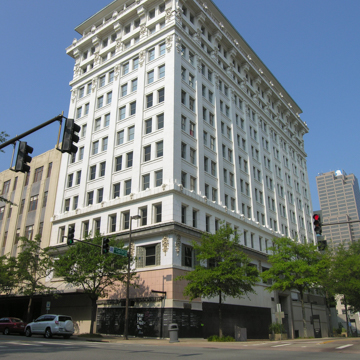The Boyle Realty Company purchased the State Bank Building in 1916, five years after the bank closed. When built in 1909, the short-lived bank was Arkansas’s second skyscraper and the state’s tallest building. At eleven stories, it surpassed the Southern Trust Building (PU16), Arkansas’s first skyscraper, by one story. The Boyle Building reflects the turn-of-the-twentieth-century preference for skyscraper design in its tripartite massing, with a strong base, multiple stories of office space, and a distinctive cap. Its form and materials are also typical of Mann’s skyscraper designs at this time—white in color, with profuse terra-cotta ornament across the upper floors and a bold cornice and deep eaves. The twelfth-floor penthouse story was added to the building in 1949, and its design is in keeping with Mann’s work. Most of the other alterations to the building have centered on the first floor storefronts. The building is waiting a new use.
You are here
Old Boyle Building (State Bank Building)
If SAH Archipedia has been useful to you, please consider supporting it.
SAH Archipedia tells the story of the United States through its buildings, landscapes, and cities. This freely available resource empowers the public with authoritative knowledge that deepens their understanding and appreciation of the built environment. But the Society of Architectural Historians, which created SAH Archipedia with University of Virginia Press, needs your support to maintain the high-caliber research, writing, photography, cartography, editing, design, and programming that make SAH Archipedia a trusted online resource available to all who value the history of place, heritage tourism, and learning.















